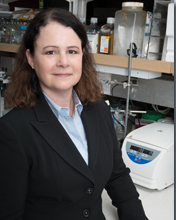Posted by Amanda Rickard on May 1, 2017

Thanks to Dr. Joel Chamberlain (University of Washington, Seattle) who answered our questions about the work that she and her lab are doing to better understand FSHD and develop successful therapies.
How did you first become interested in FSHD?
I really think it was my involvement in the small group assembled in about 2005 by Jack Shaw and Stephen Tapscott who then recruited Silvere van der Maarel, other researchers, and later the Colellas. The purpose of the group was to investigate how the genetic changes resulted in FSHD disease. Around 2007 the group asked me to join as a gene therapy expert to potentially develop an AAV-based therapy (editor’s note: AAV is a type of virus that has been tested widely as a way to deliver gene therapy for genetic diseases). At that point we all were thinking that our target for FSHD therapy was DUX4, and I was invited to sit in on a meeting after expressing interest in joining the group. It was quite exciting to participate in these open discussions. Our knowledge developed quickly and we brainstormed to design experiments that would tell us how DUX4’s genetics could cause FSHD, findings that are now helping us to develop therapies.
What does your lab study?
We began by studying and developing AAV shuttle vectors for muscle to destroy the gene product from DUX4, which was intended as a method for gene therapy and FSHD treatment. This work led to an interest in developing a relevant mouse model to study how the disease develops from the production of DUX4 protein and to better inform us of potential therapeutic targets and treatment approaches. This idea is challenging, since making a mouse model of FSHD means adding DUX4 to mouse muscle to cause damage. The tricky part was thinking about how we could express DUX4 in a way that was most reflective of human disease.
We decided to use the endogenous DUX4 promoter (editor’s note: this means Joel’s lab used the sequences that naturally govern DUX4 expression in the human genome) to express DUX4 protein in adult mouse muscle, which allowed us to tune the amount of DUX4 protein we added. We’re putting together a manuscript now that will describe features of our mouse model that are in common with human disease. For instance, we can detect DUX4 expression before we see any overt muscle problems. We’ve picked up cells and proteins of the immune system that look similar to that seen in humans affected by FSHD, including mononuclear immune infiltrating cells. We’ve also done RNA sequencing to identify pathways that are involved in disease that mimic those seen in humans, and we can identify the elusive DUX4 protein in human FSHD tissue for the first time. This information will be detailed in an upcoming publication.
Next we want to go more in depth into what DUX4 is doing in the muscle cells – how is it affecting regeneration, immune response, etc?
What sort of work has funding from Friends supported in your lab?
Before any of the major funding agencies would have taken up these projects, Friends was able to provide seed money to help us to obtain preliminary data that we needed to apply for large grants. Our work wouldn’t have been possible without that seed funding.
How does your work contribute to a treatment for FSHD?
Without a clear understanding of the pathophysiology (editor’s note: disease mechanisms), therapies can be developed prematurely, which can have detrimental effects and set back the entire field of FSHD research. We wanted to feel confident that any therapies developed would have the highest probability of working. Without a firm foundation of the disease mechanism it’s almost impossible to move from testing therapies in animals to human patients. I’m co-developing an approach to target and turn down DUX4 expression directly as we gain greater understanding of the disease, so using the mouse model we can determine if our treatment strategies are likely to be safe to bring to the clinic.
What’s the most interesting finding in your research so far?
Our work emphasizes that very little DUX4 needs to be expressed to cause disease and mimic the subtle and progressive features of FSHD, which has always been a question since it was so difficult to detect DUX4 in patient samples. The subtlety of this disease is profound and unusual, and we’ve learned a lot about it from our mouse model. We know that it’s important to model these unusual features of DUX4 in order to better understand FSHD and develop effective therapies.
Dr. Chamberlain is a Research Assistant Professor in Medical Genetics at the University of Washington’s Department of Medicine. She can be reached at jrcham@uw.edu.
You can read more about the grants her lab has received from Friends of FSH Research on our blog:
Linking genotype to phenotype in human FSHD muscle biopsies and mouse muscle expressing DUX4 protein
Postnatal modeling of FSHD in mice
RNA Interference as an investigative & therapeutic tool for FSHD
Development of an RNAi-based therapy for FSHD





Connect with us on social media